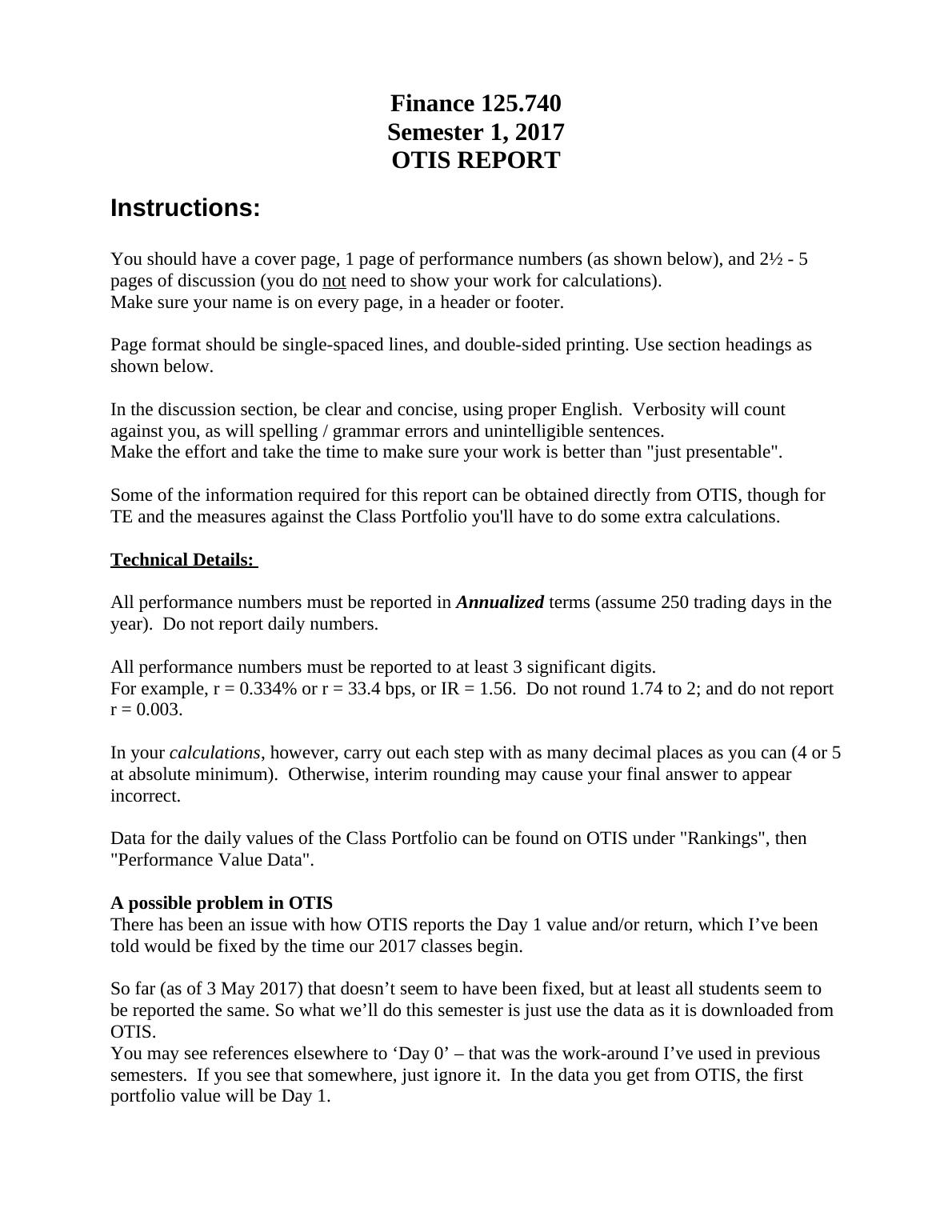Finance: OTIS Report
Added on 2019-10-18
4 Pages1336 Words154 Views
Finance 125.740 Semester 1, 2017OTIS REPORT Instructions:You should have a cover page, 1 page of performance numbers (as shown below), and 2½ - 5 pages of discussion (you do not need to show your work for calculations).Make sure your name is on every page, in a header or footer.Page format should be single-spaced lines, and double-sided printing. Use section headings as shown below.In the discussion section, be clear and concise, using proper English. Verbosity will count against you, as will spelling / grammar errors and unintelligible sentences.Make the effort and take the time to make sure your work is better than "just presentable".Some of the information required for this report can be obtained directly from OTIS, though for TE and the measures against the Class Portfolio you'll have to do some extra calculations.Technical Details: All performance numbers must be reported in Annualized terms (assume 250 trading days in the year). Do not report daily numbers.All performance numbers must be reported to at least 3 significant digits. For example, r = 0.334% or r = 33.4 bps, or IR = 1.56. Do not round 1.74 to 2; and do not report r = 0.003.In your calculations, however, carry out each step with as many decimal places as you can (4 or 5at absolute minimum). Otherwise, interim rounding may cause your final answer to appear incorrect. Data for the daily values of the Class Portfolio can be found on OTIS under "Rankings", then "Performance Value Data". A possible problem in OTISThere has been an issue with how OTIS reports the Day 1 value and/or return, which I’ve been told would be fixed by the time our 2017 classes begin.So far (as of 3 May 2017) that doesn’t seem to have been fixed, but at least all students seem to be reported the same. So what we’ll do this semester is just use the data as it is downloaded from OTIS. You may see references elsewhere to ‘Day 0’ – that was the work-around I’ve used in previous semesters. If you see that somewhere, just ignore it. In the data you get from OTIS, the first portfolio value will be Day 1.

Name ___________________________For the Sharpe, Treynor and Jensen calculations you will need the risk-free rate. You can get the daily numbers from OTIS on the Rankings page for Sharpe. Download the spreadsheet (at the bottom of that page) "How was the Sharpe Ratio for my portfolio calculated." That spreadsheet has the daily risk-free rate numbers (those are the rates I will use to calculate these stats).When you calculate your Beta, beware you may get odd numbers (like -4.5 or 126). As you know, portfolio betas should be somewhat close to 1, so that may seem like an error. However, with only a few observations (as we have in these portfolios), strange numbers can occur. So, check your work carefully, but it may be correct. If after checking your work the beta looks correct, report that and use it for the Treynor and Jensen measures (and don't forget there are two Benchmarks – Russell 1000 and Class Portfolio - so you'll have two betas).There are two versions of the Sharpe ratio; the original which assumed a constant Risk-free rate, and the revised (modern) version, which allows the risk-free rate to change daily. Use the modernversion (which we went over in class).Report “Excess Return” and “Active Return” as we have discussed in class.The requested Std Dev is the std(Excess Return), therefore the number used in the Sharpe ratio.Tracking error must be calculated using the industry version, as we have done in class. As of thiswriting OTIS reports two versions - the "Long Term Tracking Score", and the "Daily Tracking Score". Their Daily Tracking Score is the industry standard that we use. The TE reported for your portfolio against the Russell1000 will probably be close to correct, but may not be exact, due to the issue with Day 1 and Day 0 (noted above). So, you should calculate this yourself (and of course you have to calculate TE against the Class Portfolio).The required Graph is only for my reference -- it doesn't matter whether you do it in returns (as shown in the template), or in Portfolio Values (as shown in the OTIS performance value graph page). For all calculations requiring standard deviation, variance, or covariance (TE, Sharpe, Beta, etc), use the population version of the formula. (e.g. if using Excel, that means using function STDEVP, rather than STDEV.)The report is due 9 June, 2017, 1pm.You must submit the hardcopy in the provided box outside the main office (near my office).

End of preview
Want to access all the pages? Upload your documents or become a member.
Related Documents
Wastewater Engineering Laboratory Reportlg...
|2
|683
|244
